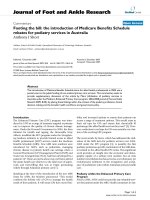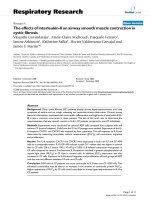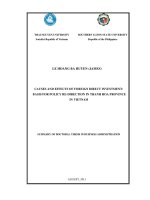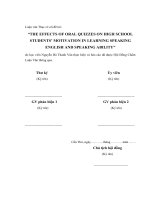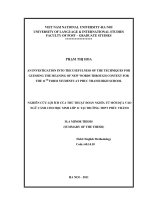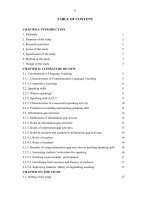The effects of teaching reading through multimedia for gifted studentss in vinh long province
Bạn đang xem bản rút gọn của tài liệu. Xem và tải ngay bản đầy đủ của tài liệu tại đây (728.26 KB, 91 trang )
MINISTRY OF EDUCATION AND TRAINING
VIETNAM NATIONAL UNIVERSITY – HO CHI MINH CITY
UNIVERSITY OF SOCIAL SCIENCES AND HUMANITIES
NGUYỄN LÊ BÍCH HIỀN
THE EFFECTS OF
TEACHING READING
THROUGH MULTIMEDIA
FOR GIFTED STUDENTS
IN VINH LONG PROVINCE
SUPERVISOR: NGUYỄN HOÀNG TUẤN, Ph.D
HO CHI MINH CITY, 2008
MINISTRY OF EDUCATION AND TRAINING
VIETNAM NATIONAL UNIVERSITY – HO CHI MINH CITY
UNIVERSITY OF SOCIAL SCIENCES AND HUMANITIES
NGUYỄN LÊ BÍCH HIỀN
THE EFFECTS OF
TEACHING READING
THROUGH MULTIMEDIA
FOR GIFTED STUDENTS
IN VINH LONG PROVINCE
A THESIS SUBMITTED IN PARTIAL FULFILMENT OF THE REQUIREMENTS
FOR THE DEGREE OF MASTER OF ARTS (TESOL)
SUPERVISOR: NGUYỄN HOÀNG TUẤN, Ph.D
HO CHI MINH CITY, 2008
STATEMENT OF AUTHORSHIP
I certify that this thesis entilted “THE EFFECTS OF TEACHING READING
THROUGH MULTIMEDIA FOR GIFTED STUDENTS IN VINH LONG
PROVINCE” is my own work.
This thesis has not been submitted for the award of any degree or diploma in
any other institutions.
Ho Chi Minh City, 2008
Nguyen Le Bich Hien
i
ACKNOWLEDGEMENTS
I would first like to gratefully acknowledge the invaluable and generous
assistance given to me by my thesis supervisor, Dr. Nguyen Hoang Tuan, over
the lengthy period of the researching and writing of the thesis. I could not have
finished this thesis without his encouragement and constant guidance.
I am greatly indedted to all my teachers in M.A course 2003 for their
dedication and helpful instructions during the course.
My special thanks to all those who helped me in the study, in particular,
colleages in English Department for their help with the interview and all the
students in class 10A at Nguyen Binh Khiem high school for the gifted. Many
thanks also go to Mr. Le Quang Sang, my closest friend, for his valuable help.
I am deeply thankful to my husband, lovely son, and two sisters who
encouraged and gave me great impetus to fulfill the thesis. And I would like to
send my best gratitude to my parents who devote all their lives to the children’s
education.
Despite all the help I had, many errors and deficiencies may remain in this
thesis; for these I alone am responsible.
ii
ABSTRACT
In response to an appeal from the Minister of Education and Training
to high schools for the gifted to improve the quality of education students
toward regional and international standards, teaching staff in English
Department are making great efforts to further promote the foreign language
teaching and learning process. In the last few years, there have been dramatic
changes in the ways that languages are taught with the replacement of grammar
translation by communicative approaches and the introduction of technological
tools. Under such a circumstance, there has been a breakthrough in the
application of multimedia in the teaching methods to meet the practical
demands of a new era at Nguyen Binh Khiem high school for the gifted.
This thesis was conducted with the purpose of finding the positive
impacts of multimedia on the process of teaching and learning L2 reading
skills. The objective of this study was to determine whether the application of
multimedia helps the students improve their language knowledge, reading
skills, change their reading styles, create an interesting atmosphere to study
better, as well as to help the teachers fulfill their tasks in a complete and
smooth way. In addition, the thesis also presents the ways in which multimedia
is used to design three stages of teaching a reading lesson, and suggestions to
make best use of multimedia are also given. The students in grade 10 at
Nguyen Binh Khiem high school for the gifted in Vinh Long Province in mid2007, were selected as the research samples. The research design used the
questionnaires for students and interviews with the teachers to obtain the
percentage of the data.
Overall, research findings showed the respondents’ agreement on the
high level of effectiveness of multimedia in the process of teaching and
learning L2 reading skills and its implementation in 3 stages of teaching a
reading lesson. However, some obstacles in the process of teaching and
learning through multimedia were also presented and discussed.
iii
TABLE OF CONTENTS
S tatement of authorship
Acknowledgements
Table of contents
List of tables
List of figures
Abbreviations
CHAPTER ONE INTRODUCTION
I.1 . Background to the study ......................................................................................1
I.2. Descriptions of the school and English syllabus ...............................................3
I.3 . Problem identification..........................................................................................4
I.4 . Research questions .............................................................................................5
I.5 . Significance of the study .....................................................................................5
I.6 . Limitations of the study .......................................................................................6
I.7 . Organization of the study ....................................................................................7
CHAPTER TWO LITERATURE REVIEW
II.1. Approaches to multimedia teaching ..................................................................8
II.1.1 What is instructional multimedia? ................................................................9
II.1.2. Research on the impact of multimedia on education ..............................10
II.1.3. Selecting online materials .........................................................................12
II.1.4. Students’ attitudes and reaction towards multimedia ...............................13
II.2. Approaches to teaching reading skills.............................................................. 13
II.2.1. Reading purposes and strategies ................................................................14
II.2.2. Characteristics of efficient reading............................................................19
II.3. Multimedia and its impact on the improvement of reading skills.................... 20
II.4. Motivating students .......................................................................................... 21
II.5. Summary........................................................................................................... 23
iv
CHAPTER THREE METHODOLOGY
III.1. Research design .............................................................................................. 24
III.2. Subjects of the study ...................................................................................... 25
III.2.1. Students ....................................................................................................25
III.2.2. Teachers....................................................................................................26
III.3. Instruments ..................................................................................................... 26
III.4. Procedures and materials................................................................................. 28
III.5. Descriptions of teaching method..................................................................... 29
III.6. Summary ......................................................................................................... 30
CHAPTER FOUR DATA COLLECTION AND ANALYSIS
IV.1. Data Analysis .................................................................................................. 31
IV.1.1. Results and analyses from the questionaires ............................................31
IV.1.2. Results and analysis from the interview ...................................................41
IV.2. Discussion from the results of the questionnaire and the interview ............... 44
IV.2.1. Advantages of applying multimedia in reading classes ...........................44
IV.2.2. Obstacles of applying multimedia in teaching and learning reading .......48
IV.3. Summary ......................................................................................................... 49
CHAPTER FIVE CONCLUSION AND RECOMMENDATIONS
V.1. Conclusion ........................................................................................................ 50
V.2. Implications of multimedia on the three stages of a reading lesson................. 51
V.3. Recommendation .............................................................................................. 53
V.4. Summary........................................................................................................... 57
BIBLIOGRAPHY........................................................................................................58
APPENDIX .................................................................................................................61
v
LIST OF TABLES
Table 4.1: Benefits students got when learning reading through multimedia ........ 36
Table 4.2: Parts of a reading lesson that interest students...................................... 39
Table 4.3: Advantages that multimedia brings to the teachers .............................. 43
Table 4.4: Disadvantages challenged the teachers ................................................ 43
Table 4.5: Parts of a reading lesson interest the teachers ....................................... 44
vi
LIST OF FIGURES
Figure 4.1: Students’ secondary school .................................................................. 31
Figure 4.2: Students’ marks obtained in the entrance examination to Nguyen
Binh Khiem high school for the gifted ................................................ 32
Figure 4.3: Students’ purposes in learning reading ................................................ 33
Figure 4.4: Number of hours students spend on reading English materials ........... 33
Figure 4.5: Students’ difficulties in learning reading ............................................. 34
Figure 4.6: Students’ interest in learning reading through multimedia .................. 35
Figure 4.7: Obstacles students encounter when learning through multimedia ....... 40
Figure 4.8: Teacher’s frequency in teaching reading through multimedia............. 42
vii
ABBREVIATIONS
CUP:
Cambridge University Press
EFL:
English as a Foreign Language
ELT:
English Language Teaching
ESL:
English as a Second Language
L2:
Second / Foreign Language
OUP:
Oxford University Press
USSH:
University of Social Sciences and Humanities
WWW:
World Wide Web
viii
CHAPTER ONE
INTRODUCTION
I.1 . Background to the study
The development of computer-based reading curricula had been taking place
before the existence of microcomputers in the late 1970s. Central mainframe
computers dispatched instructional lessons to individual terminals in different
locations. The relative difficulty in using mainframe computers for educational
applications led developers to consider the more practical and affordable
microcomputers. The availability of such computers encouraged stand-alone
programs designed for a single reading skill (Reinking & Bowles, 1996).
The first major computer-based reading curriculum was the work of Richard
Atkinson in 1964 at Stanford University which was supported by a grant from the
U.S. Office of Education. The project was a first-grade reading curriculum aimed to
lessen the need for classroom teachers (Atkinson, 1974).
These research attempts were exclusively for native language reading. Only
during the past ten years has the use of computers in the field of teaching second
language reading been increasing. A variety of studies have shown the importance
of using computers in ESL reading (Willet, 1992). Chun & Plass (1996)
investigated how reading comprehension can be facilitated with a multimedia
application for language learning. They studied the effects of a dynamic visual
advance organizer on the macro level and the effects of multimedia annotations for
single vocabulary items on the micro level. Furthermore, they examined the
relationship between vocabulary acquisition and reading comprehension. The
results of their study indicated that the visual advance organizer does aid in overall
comprehension and that annotations of vocabulary items consisting of both visual
and verbal information help more than verbal information only. Also, a moderate
correlation between vocabulary knowledge and reading comprehension was found.
Chun & Plass claimed that the results support the dual coding theory and its
extension to multimedia learning and emphasize the significance of visual
1
Chun D. & Plass J. (1997) based on underlying theories of foreign language
reading comprehension and text comprehension with multimedia, discussed "how
foreign language reading research is focusing increasingly on the cognitive
processes involved in reading, that is, the interaction of lower-level, bottom-up
processes such as vocabulary acquisition with higher level, top-down processes
such as activating prior knowledge" (p.60). They merged this understanding with
existing research on learning with technology to find out how students with
different learning abilities put together "verbal and visual information". Their goal,
in this study, was not to determine the effectiveness of multimedia on reading
comprehension, but rather the learners who may benefit from multimedia
instruction.
Whereas Chun & Plass used the underlying theory of foreign language
reading comprehension with multimedia, Preisinger, R. et al., (1988) used the
schema theory as a basis to evaluate reading software programs. They developed
criteria and questions to evaluate: 1) interactive capabilities of reading software
(e.g. its flexibility, response to student errors, and ability to make a distinction
between major and unimportant errors), 2) information processing (e.g. support of
the use of prediction and problem solving strategies, use of text-based activities in
the context of a reading passage, and encouragement of analyzing texts), 3)
background knowledge (e.g. building schemata through pre-reading activities), and
4) general software construction and implementation.
In drawing conclusion about the use of computers for reading instruction,
previous research clearly supported the idea that computer-based instruction
facilitates students' reading comprehension and increases their reading speed. This
conclusion is supported by the results of the preceding studies and a series of other
studies conducted by Kulik, Bangert, & Williams, 1983 who found significant
2
I.2. Descriptions of the school and English syllabus
Nguyen Binh Khiem high school for the gifted students is the only one in
Vinh Long province that is in charge of training good students both accademically
and morally . It consists of 30 classes for 3 grades: 10 th , 11 th , and 12 th in which
there is one English major class for each grade. The level of English major
students is higher thwn the non-major and different textbooks are used,
particularly, the advanced English book is for the major and the basic is for the
others. In addition, they have to cover some extra materials distributed by the
Ministry of Education and Training and compiled by the teacher in charge. The
total number of periods (forty five minutes per period) per week for the major is
eight and three for the non-major.
There are 16 units in the advanced English textbook. Each unit must be
fulfilled in 7 periods; among them, reading comprehension takes 2 periods. It is
obvious to realize the importance and priority of reading skills to students.
Students’ achievement is assessed through doing tasks in class, the fifteen-minute
quiz is given as soon as one unit is finished, one-period test after two units are
ended and the examination is given at the end of each semester (after 8 units are
finished).
In addition, a classroom has between 20 and 45 students. Each classroom is
equipped with a blackboard, a teacher’s desk, tables and chairs for students.
Besides, there is a lab room which is well-equipped with facilities such as a TV, a
computer for teacher, lab system boxes and head sets for both teacher and students;
3
and a multimedia room where internet is available to, which is very convenient for
teaching and learning.
I.3 . Problem identification
Achievements in the Information Technology have been applied in teaching
and learning since 1960s. However, applying these achievements in teaching and
learning a foreign language has brought about since 1900s. And a lot of research on
multimedia and its application in teaching and learning a foreign language have
been done all over the world and a variety of national research have also been
done on methods and techniques in teaching reading in Vietnamese context. Most
of the thesis on improving teaching reading are based on coursebooks, and some
focus on the effectiveness of multimedia in improving students’ reading
competence. However no thesis is about teaching reading through multimedia for
high school students in Vietnamese context especially in Vinh Long province.
In addition, the world is in a new era thanks to the rapid development of
applying technology into all fields of our life. In the field of education and training,
information technology has made a contribution to modernizing teaching facilities
as well as teaching methodology renewal. To a high school for gifted students, the
need of applying technology into teaching and learning is highly increasing to meet
the social needs and educational objectives.
Last but not least, English is an international language that is compulsory in
learning programs from elementary to high school, college, and even university.
The teaching and learning a foreign language of high school students in Vinh Long
province focuses mostly on reading and communication skills. In fact, reading
comprehension takes a great deal of time in the English curriculum as well as a
great part in almost examinations such as the high school graduation and the
entrance university examinations. As a result, reading skills are paid greatly
attention and most of reading classes are kept eyes on by students. Generally,
4
is often referring to the purposes to
achieve knowledge or information and each individual has his or her own purposes
to read. Moreover, it is undeniable that teaching methods play a very important
part in making ease students’ reading skills beside their knowledge about the
culture, the world, and the language. On the other hand, most of high school
students showed that with teaching methods applied nowadays, reading classes do
not interest them and often make them feel bored and discouraged because they
have to deal with reading texts with a long list of new words, exercises, some
grammar points, and repeated activities.
I.4 . Research questions
Reading and understanding materials in a foreign language is one of the
most objectives clarified at school, and how to help improve reading proficiency
for high school students is a burning question. A large number of technniques have
been in use so far, so do the achievements in technology especially multimedia.
However, in the context of a high school for gifted students in Vinh Long province,
whether the application of multimedia in teaching reading skill is effective or not.
That leads to questions for the thesis
9 What benefits do students receive in reading classes with multimedia ?
9 What obstacles do students encounter in reading classes with multimedia ?
9 What are students’ attitudes towards the reading lessons with multimedia?
9 How is an effective reading lesson using multimedia designed?
I.5 . Significance of the study
To help improve students’ reading outcome, problems interfering should be
taken account to find out the best ways to create an exciting atmosphere and an
active knowledge environment for my students to approach reading skills perfectly
and make them feel like reading lessons. In addition to the renovation of teaching
methods, the application of multimedia in teaching and learning becomes a crucial
factor.
5
There have been some studies about the educational application of
multimedia in teaching different English skills for different types of students, but
the most important thing is whether these studies really help high school students
improve their reading skills effectively. The aim of the thesis is to examine the
benefits multimedia brings to both teachers and students as well as the obstacles
they are encountered in reading classes; identify how teacher use multimedia in
strategies to teaching a reading lesson; and suggests some measures to overcome
the obstacles and best ways to teach reading through multimedia effectively for
both English major and non English major students in Nguyen Binh Khiem high
school for the gifted in Vinh Long province. Moreover, the thesis is expected to
make contribution to the improvement of reading skills of learners, create a great
motivation, and make a great change in the way of teaching reading as well as
learning habit in reading of the students. Hopefully, this will receive the support of
the teaching staff, the colleagues, and other educational institutions.
I.6 . Limitations of the study
One limitation of the study is that only the tenth grade English major
students who were studying the advanced English book were concerned in the
study, not including students who were studying the basic English in other classes.
In addition, the sample group of the study is quite small with 29 students, so it can
not clarify the whole view of multimedia in teaching different types of students.
Another limitation is that the interpretation of the results depends on the
questionaire conducted at the English class, and the interview with most of the
teachers in Nguyen Binh Khiem high school for the gifted. It does not mean that the
results are the same if the study is conducted with other samples in other schools.
6
I.7 . Organization of the study
The thesis consists of five chapters.
Chapter one refers to the background, problem identification, and
significance of the study. It also clarifies the limitations of the study.
Chapter two introduces some terms relating to multimedia together with
reading approach and the impacts of multimedia on teaching and learning L2
reading. In addition, the reviews of the ideas of other researchers are also stated to
see clearly the viewpoint of the thesis doer.
Chapter three describes the methodology employed in the study. A
presentation of the research questions, the research design, the description of
characteristics of the subjects, the study instruments and the procedures to collect
data are displayed in this chapter.
Chapter four refers to the analysis of the data collected in the previous
chapter in order to discuss about the advantages, disadvantages and how much
effectiveness of multimedia impacts on teaching and learning reading
comprehension.
Chapter five draws out the conclusion, the way in which multimedia helps
improve teaching and learning reading, as well as presents some suggestions to
make reading lessons more interesting and efficient to both teachers and students.
7
CHAPTER TWO
LITERATURE REVIEW
This chapter provides an overview of multimedia combined with reading a
foreign language and traces back relevant studies involving multimedia and reading
skills in the recent decades to find out the positive impacts of multimedia on
teaching reading skill.
II.1. Approaches to multimedia teaching
Since the early 1960s, language teachers have witnessed dramatic changes in
the ways that languages are taught. The focus of instruction has broadened from the
teaching of discrete grammatical structures to the fostering of communicative
ability (Warschauer & Kern, 2000). Together with the appearance of
communicative approaches, the emergence of multimedia tools in language
teaching has attracted the attention of teachers, academicians, educationalists and
experts. From the opinions of those who have studied the role and function of the
tools, it seems to be rather controversial and unlikely to produce a definite answer
to the apparently simple question, "Do multimedia tools actually enhance and
promote foreign language learning?"
Brinton (2001) supposed that multimedia tools serve as an important
motivator in the language teaching process because "media materials can lend
authenticity to the classroom situation, reinforcing for students the direct relation
between the language classroom and the outside world" (p. 461). Hartnett (as cited
in Brinton, 2001) shared that perspective by saying that media tools appeal to
students' senses and help them process information, thus empowering their
understanding of the target culture and increasing their motivation toward language
learning, reinforcing the teaching points, and saving the teacher unnecessary
explanation. Similar findings have been made public by Warschauer (1996), Lee
(1997), Bush (1997), Beauvois (1998), and Meunier (1998) (as cited in Brauer,
2001).
8
The rationales of these researchers stem from the awareness that the
emphasis in foreign language learning has moved from a traditional approach - one
that focuses on the study of the language itself - to a communicative approach in
which learners acquire both linguistic and cultural competence. The application of
multimedia tools can foster this goal by creating "a learning environment wherein
students practice their language skills and acquire target culture" (Brauer, 2001,
p.130). Mollica (as cited in Brinton, 2001) also suggested that media provide
teachers with a means of presenting material in a time-efficient and compact
manner, and of stimulating students' senses, thereby helping them to process
information more readily. In other words, such media as audio and video
equipment, computers and related software and Internet sources have been seen as
effective tools to develop students' language competence so that they can interact
with native speakers comfortably and successfully in real-life situations. Some
other studies showed the use of media has helped involve students more integrally
in the learning process and to facilitate language learning by making it a more
authentic, meaningful process (Nunan, 1999; Sperling, 1996; Warschauer, 1995 (as
cited in Brinton, 2001)).
II.1.1 What is instructional multimedia?
There are many ways in which multimedia can be defined. This term is
traced back from the early time. According to Wang and Cheung (2003:216),
multimedia
traditionally refered
to the use of several media devices in a
coordinated fashion, such as, synchronized slides with audiotape, but nowadays, it
refers particularly to a combination of various media presented on the computer.
In another way, “ Instructional media are means by which information can
be delivered to a learner” (Heinnich at al., 1993:5). These means may be video,
audio, text, graphics, a combination of various media called multimedia or the
powerful and indispensable tool: computer software. “The term multimedia
conveys the notion of a system in which various media (e.g., text, graphic, video,
9
and audio) are integrated into a single delivery system under computer control
( Newby, Stepich, Lechman & Russel, 2000).
II.1.2. Research on the impact of multimedia on education
It is proved that multimedia has a great impact on education. It eases and
makes the process of teaching and learning more effective thanks to the benefits it
brings to teachers and learners. First, multimedia can bring the real world to
students. It means that students do not have to go to the foreign countries, they just
sit in front of the computer, click the mouse to the web from that they want to
search the information. Then, motion media and sequential still visuals can
demonstrate the process that is better for students to practise the skill. (Newby,
Stepich, Lechman & Russel, 2000:100)
They also proved that multimedia is powerful because multimedia entails
hypermedia. The multimedia resources are all linked together, so teachers and
learners can navigate their own path by simply pointing and clicking the mouse. It
is due to link-ability that makes information more accessible and order it in an
instructional framework, which allows teachers to lead the students to the
pedagogically meaning purpose and permit them to explore it easily according to
their interests.
Warschauer (1996), to some extent, agreed with the idea of link-ability that
hypermedia supplies. He also stated some advantages of hypermedia on educational
purpose. On the first place, he refered to the authentic learning environment since
listening is connected with seeing, just like in the real world. And learning by
seeing is better because 83% we learn is through the sense of sight, only 10%
through the sense of hearing. Moreover, skills are not taught lonely but
intergratedly, as multimedia can make it natural to combine reading, writing,
speaking and listening in a single activity, which helps students equally develop
their language skills. The final advantage of hypermedia is that it mainly focuses on
10
the content, but not language form or learning strategies. However, learning
strategies contribute to the process of motivating students to learn better, and the
important thing is to see how much multimedia can interfere this process.
In actual fact, the use of hypermedia tools in the learning process has
important implications for schools. Dede (1994) sees uses of hypermedia tools
beyond simple presentations of information. Firstly, he stated that these tools offer
new methods of structured discovery. In addition, they address varied learning
styles; as a result, students may change their learning styles in accordance with the
objectives of the lesson and the learners’ needs. Thirdly, they motivate and
empower students to study better. The last impact is they accommodate nonlinear
exploration, allowing teachers to present information as a web of interconnections
rather than a stream of facts. Bagui (1998: 4) shares the ideas with Dede by saying
multimedia “may have unique capabilities to facilitate learning because of the
parallels between multimedia and the natural way people learn”, that is , through
visual information and imagery.
Qiyun, W and Sum, C (2003: 217)
also reported some benefits of
hypermedia systems on learning process because (1) they improve effectiveness of
learning since human organs may sense information simultaneously; (2) they
provide a context-rich learning environment since multimedia lesson materials are
presented with multiple media; (3) non-linear organisation of hypermedia systems
improve learners’ higher-order thinking skills because users have to analyse what
they have learnes and make decisions as to where to go; (4) a user-friendly
interface may motivate learners’ interest since it is attractive and/ or interactive;
and (5) they provide additional information which helps in the learner’s coding of
information.
11
II.1.3. Selecting online materials
Aside from the above benefits, multimedia offers learners access to
abundant source of information which can make learners feel that they are
intergrating with the world outside even in class. That’s what is called authenticity.
There is no doubt that one of the factors enhancing students’ motivation to
learn a foreign language is the syllabus. Together with the students’ book in the
sylabus, materials make a significant contribution to the improvement of students’
knowledge. Materials can be collected from various sources such as books,
newspapers, magazines, and the Internet. By using World Wide Web, students are
able to approach a large amount of information. According to Warchauer, 1996, the
information in WWW is abundant and authentic. Students are free to use these
valuable and authentic knowlegde sources even in class with the help of media.
Actually, with the advent of the Internet that can be communicated over the WWW
we now have several new and exciting ways to present information. The Web
allows the incorporation of animation, moving pictures, and sound into lessons,
which extends our abilities to present materials that encourage student interation
with the subject matter. According to Savage and Vogel, 1996, one of the
advantages of using multimedia is to convey information quickly and effectively to
all students – and keep them interested in learning.
In addition, in 2001, Brinton confirmed how authenticity can be integrated
into classroom with the help of media, the result of that is it reinforces for students
the direct relation between the language classroom and the outside world. Harnett
(as cited in Briton, 2001) shared that perspective by saying that media tools appeal
to student’s senses and help them process information, thus empowering their
understanding of the target language and increasing their motivation toward
language learning, reinforcing the teaching points, and saving the teacher
unnecessary explanation.
12
It is clear that materials are abundant and free to be logged in the Internet.
However, the important matter is how students can select authentic materials
suitable with their own learning purpose. In this context, some criteria on selecting
appropriate materials should be taken into careful consideration to help students
avoid surfing bad or wrong websites. The criteria to have a good reading text
includes that reading topic is closely related to the topic in textbook, or it covers the
culture and lifestyles of people living in English speaking countries. Furthermore,
the length of the text is between 250 and 300 words consisting of some exercises
like multiple choice questions, true – false statements, questions, or cloze text, etc,
for students to practise. The duty of the teachers in this situation is to inform
students such criteria before assigning homework.
II.1.4. Students’ attitudes and reaction towards multimedia
There are many factors that affect students’ attitudes and reaction of students
in classroom. One of them is technology – based instruction that enhances student
attitudes towards several aspects of schooling. The line of inquiry has brought most
researchers to the conclusion that the use of computers leads to more positive
student attitudes than the use of conventional instruction. The following is a
modified list of reasons why students like learning with hypermedia and
multimedia collected by Cotton (1991). Students said that they like working with
computers because computers are infinitively patient, allow students to work
privately, are fun and entertaining, individualize learning, give immediately
feedback, are great motivators, make it possible to experiment with different
options, are self-paced, do not embarrass students who make mistakes, and never
forget to correct or praise. These students preferences show their high appreciation,
and positive attitudes towards computers’ application in learning
II.2. Approaches to teaching reading skills
Research on ESL reading and efforts to improve ESL reading instruction
have grown the last twenty years. It has become difficult to synthesize the research
13
and introduction literature in ESL/EFL academic reading and foreign language
reading.
Reading can be defined in various ways according to different authors’ conception
of the reading process. In the mid-to late 1960s, Silberstein noted that reading was
seen as little more than reinforcement for oral language instruction. The main
purpose to teach reading was to examine grammar and vocabulary, or to practice
pronunciation (Silberstein, 1987).
II.2.1. Reading purposes and strategies
To make the best use of applying multimedia in teaching reading, reading
purposes and strategies should be taken account to see through the effectiveness of
its application in the process of teaching and learning reading comprehension.
II.2.1.1. Reading purposes
Learners have their own purposes to approach reading skill and it is certain
that their purposes are quite different. Some read for pleasure while others for
update information or knowledge improvement and so on. Rivers and Temperly
(1978) stated that we read to obtain information or we are sometimes curious about
the topic; Besides, reading helps us obtain instructions on how to perform some
task for our work or daily life (e.g., knowing how an appliance works); or even we
read to act in a play, to play a game, or to do a puzzle; to keep in touch with friends
by correspondence or to understand business letters; to know when or where
something will take place or what is available; to know what is happening or has
happened ( as reported in newspapers, magazines, reports); and to read for
enjoyment or excitement.
It is vital that the teachers clarify students’ purposes before asking them to read to
give a great impetus or design some tasks and activities, give some topics that
arouse their curiosity to approach the reading effectively.
14
II.2.1.2. Reading strategies
Similar to other skills, reading consists of strategies that teachers and
students have to consider to comprehend the reading purposes sufficiently.
Commonly, teachers follow a format of three strategies in a reading lesson. They
are pre-reading, while-reading, and post-reading. In each strategy, they design
different activities and tasks to set off main points of the topic and involve students
to the reading. To design an effective reading lesson through multimedia, it is
advisable that the teachers clarify the objectives of each reading stage.
The first stage is pre- reading; it aims at arousing students’ interest in the
topic by drawing on the learners’ background knowledge of the world. Some
relevant vocabulary can be generated during this stage. It is carried out before the
students have seen the text. Lee and Vanpatten (1995) stated that the initial phase
of the instructional framework must be to activate learners’ background knowledge
and direct it toward the information in the passage. In other words, schemata must
be activated and appropriate to the passage being read. Thus, the purpose of prereading stage is to give students necessary preparation as well as motivation before
they jump into reading a text. Generally, it is one of the strategies to facilitate the
reading process as well as build bridges between the reader and the information
contained in the text. According to Lee and Vanpatten (1995), this preparation is
necessary because in real life, we do not normally read because we have to but
because we want to. We usually have a purpose in reading: there is something we
want to find out, some information we want to check or clarify, some opinions we
want to match against our own.
In English classes, the situation is very often different. Usually students
read the text not because they are eager to find out its content, but because the
teachers are forced them to do. As a result, in order to help students read the text
keenly, it is really important to give students the reasons to read and give them
some tasks which can only fulfill after they read the text. In other words, students
15

